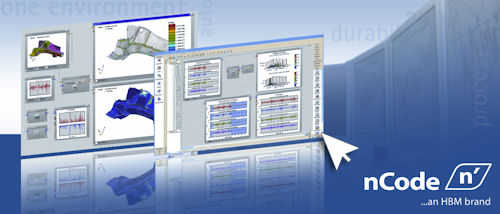Latest News
December 4, 2001
By Anthony J. Lockwood
Dear Desktop Engineering Reader:
 I know that readers of DE don’t need to be told that stress and strain analysis is an important piece of the component design process—many of you spend a good deal of time physically or virtually busting things on purpose. But typically your analyses involve a single pass: You’re searching for that point when stress and strain surpass your component’s tensile strength and it fails. The results are important stuff to know. Still, there’s a lot more to learn, such as how is that baby going to behave over the long haul. This where fatigue analysis comes in.
I know that readers of DE don’t need to be told that stress and strain analysis is an important piece of the component design process—many of you spend a good deal of time physically or virtually busting things on purpose. But typically your analyses involve a single pass: You’re searching for that point when stress and strain surpass your component’s tensile strength and it fails. The results are important stuff to know. Still, there’s a lot more to learn, such as how is that baby going to behave over the long haul. This where fatigue analysis comes in.
Fatigue analysis complements your yield stress design criteria. It extends your finite element stress results to help predict component failure over time when a part is subject to repeated applied loading yet the stresses are low, even well below, a material’s “normal” breaking point. You know, when a part breaks because it’s tuckered out. How fatigue as a physics phenomena behaves and how you can predict the effects of hidden defects and incipient cracks through fatigue analysis software is, in a nutshell, what lies on the other side of today’s Check It Out link over there.
“Introduction to Fatigue Analysis Theory” is a 45-minute, on-demand webinar from HBM-nCode, the maker of durability, test, and analysis products, including a toolset known as nCode DesignLife. This presentation is worth exploring on a number of levels, but, most simply, it’s easy to follow yet highly infaormative.
The webinar begins with a broad introduction to what constitutes fatigue and the stages of crack initiation and growth. A meaty part of these discussions serves as a concise overview of the common methods of durability analysis, Stress-Life (SN), Strain-Life (EN), and crack growth. These discussions are tight, well-illustrated (after the bullets, of course), and presented in such a manner as to appeal to engineers well-versed in durability issues as well as those who are not. That latter point speaks volumes. It’s not easy to explain how microscopic-level defects evolve into macro headaches and make it thoroughly enjoyable. HBM-nCode succeeds handsomely.
The webinar then turns to a demo of DesignLife durability analysis software. It’s fascinating. nCode is a graphical analysis process development environment. With it you use what are called “glyphs,” graphical representations of the building blocks of the analysis process, to create your workflow by dragging and dropping glyphs then piping it all together. It seems easy to use and powerful.
I once had a long conversation with a former CEO of SolidWorks about the satisfaction of explaining something complex to people and knowing they got it. The people at HBM-nCode should have that feeling about their webinar “Introduction to Fatigue Analysis.” If you need to take a crack at fatigue analysis, this is the place to start growing your knowledge.
Thanks, Pal. – Lockwood
Anthony J. Lockwood
Editor at Large, Desktop Engineering
Subscribe to our FREE magazine, FREE email newsletters or both!
Latest News
About the Author
Anthony J. Lockwood is Digital Engineering’s founding editor. He is now retired. Contact him via [email protected].
Follow DE





